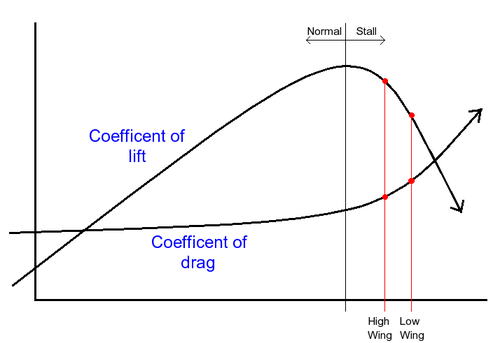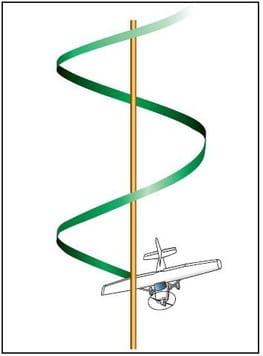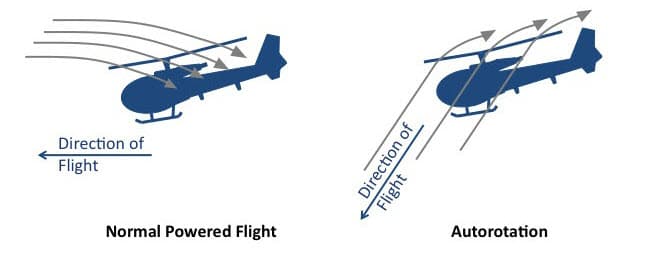# AUTOROTATION:
Table of Contents:
- Autorotation In Aircraft
- Autorotation In Helicopter
- Several Factors That Affect The Rate Of Descent In Autorotation
- Primary Ways To Control The Rate Of Descent In Autorotation
- Common Errors
Autorotation In Aircraft:
For fixed-wing aircraft, autorotation is the tendency of an aircraft in or near a stall to roll spontaneously to the right or left, leading to a spin (a state of continuous autorotation).
When the angle of attack is less than the stalling angle, any increase in angle of attack causes an increase in lift coefficient that causes the wing to rise. As the wing rises, the angle of attack and lift coefficient decrease which tend to restore the wing to its original angle of attack.
Conversely, any decrease in angle of attack causes a decrease in lift coefficient which causes the wing to descend. As the wing descends, the angle of attack and lift coefficient increase which tends to restore the wing to its original angle of attack. For this reason the angle of attack is stable when it is less than the stalling angle. The aircraft displays damping in roll.
When the wing is stalled and the angle of attack is greater than the stalling angle, any increase in angle of attack causes a decrease in lift coefficient that causes the wing to descend. As the wing descends, the angle of attack increases, which causes the lift coefficient to decrease and the angle of attack to increase.
Conversely, any decrease in angle of attack causes an increase in lift coefficient that causes the wing to rise. As the wing rises the angle of attack decreases and causes the lift coefficient to increase further towards the maximum lift coefficient. For this reason the angle of attack is unstable when it is greater than the stalling angle. Any disturbance of the angle of attack on one wing will cause the whole wing to roll spontaneously and continuously.
When the angle of attack on the wing of an aircraft reaches the stalling angle the aircraft is at risk of autorotation. This will eventually develop into a spin, if the pilot does not take corrective action.

Autorotation In Helicopter:
In a helicopter, an autorotative descent “autorotation” is a power-off maneuver in which the engine is disengaged from the main rotor disk and the rotor blades are driven solely by the upward flow of air through the rotor. In other words, the engine is no longer supplying power to the main rotor. The most common reason for an autorotation is failure of the engine or drive line, but autorotation may also be performed in the event of a complete tail rotor failure, since there is virtually no torque produced in an autorotation. In both cases, maintenance has often been a contributing factor to the failure.
Engine failures are also caused by fuel contamination or exhaustion as well resulting in a forced autorotation. If the engine fails, the freewheeling unit automatically disengages the engine from the main rotor, allowing it to rotate freely. Essentially, the freewheeling unit disengages anytime the engine revolutions per minute (rpm) is less than the rotor rpm. At the instant of engine failure, the main rotor blades are producing lift and thrust from their angle of attack (AOA) and velocity.
By lowering the collective (which must be done immediately in case of an engine failure), lift and drag are reduced, and the helicopter begins an immediate descent, thus producing an upward flow of air through the rotor disk. This upward flow of air through the rotor disk provides sufficient thrust to maintain rotor rpm throughout the descent. Since, the tail rotor is driven by the main rotor transmission during autorotation, heading control is maintained with the anti-torque pedals as in normal flight.
Several Factors That Affect The Rate Of Descent In Autorotation:
- Bank angle
- Density altitude
- Gross weight
- Rotor rpm
- Trim condition
- Airspeed
Primary Ways To Control The Rate Of Descent In Autorotation:
The primary ways to control the rate of descent are with airspeed and rotor rpm. Higher or lower airspeed is obtained with the cyclic pitch control just as in normal powered flight. Rate of descent is high at zero airspeed and decreases to a minimum at approximately 50–60 knots, depending upon the particular helicopter and the factors just mentioned. As the airspeed increases beyond that which gives minimum rate of descent, the rate of descent increases again.
When landing from an autorotation, the only energy available to arrest the descent rate and ensure a soft landing is the kinetic energy stored in the rotor blades. Tip weights can greatly increase this stored energy. A greater amount of rotor energy is required to stop a helicopter with a high rate of descent than is required to stop a helicopter that is descending more slowly. Therefore, autorotative descents at very low or very high airspeeds are more critical than those performed at the minimum rate of descent airspeed.
Use collective pitch control to manage rotor rpm. If rotor rpm builds too high during an autorotation, raise the collective sufficiently to decrease rpm back to the normal operating range, then reduce the collective to maintain proper rotor rpm. If the collective increase is held too long, the rotor rpm may decay rapidly. The pilot would have to lower the collective in order to regain rotor rpm. If the rpm begins decreasing, the pilot must again lower the collective. Always keep the rotor rpm within the established recommended range for the helicopter being flown.
Common Errors In Autorotation:
- Failing to use sufficient anti-torque pedal when power is reduced.
- Lowering the nose abruptly when power is lost.
- Failing to maintain Rotor RPM (RRPM) within Flight Manual limits during the descent.
- Flaring at the wrong height.
- Flaring too aggressively or not aggressively enough.
- Terminating the flare too high and / or application of up-collective lever at an excessive height, resulting in a hard landing, loss of heading control, and possible damage to the tail rotor and to the main rotor blade stops.
- Failing to level the helicopter before touchdown.
To find more topics on our website…
Do you want to refer wikipedia? Please click here…
Keywords: autorotation, autorotation helicopter landing, autorotation in aircraft, autorotation landing, autorotation aerodynamics


